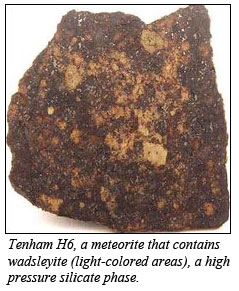 Researchers from Caltech and UNLV, with the support of scientists from Carnegie, have demonstrated a new way to create in the laboratory a mineral that only exists in meteorites and deep below the Earth's crust. The discovery indicates that the formation of planets and certain minerals in the early solar system may have involved collisions between much smaller bodies than previously thought.
Researchers from Caltech and UNLV, with the support of scientists from Carnegie, have demonstrated a new way to create in the laboratory a mineral that only exists in meteorites and deep below the Earth's crust. The discovery indicates that the formation of planets and certain minerals in the early solar system may have involved collisions between much smaller bodies than previously thought.
In work carried out in part at NSLS-U2A and at HPCAT, the group reports evidence for small quantities of the mineral wadsleyite formed upon shock compression of thin layers of magnesium oxide and fused quartz. Wadsleyite is widely believed to be the most abundant mineral in the Earth between 410 and 520 km depth. The conditions under which wadsleyite forms are known from static high pressure experiments, but it had never before been recovered from a laboratory-scale shock wave experiment, which lasts only a minor fraction of a second. However, wadsleyite has been found in some meteorites that consist of debris that formed upon natural shock events during collisions of proto-planetary bodies in the early solar system, as shown in the accompanying figure. Based on the size of the wadsleyite grains recovered from the experiment, it can be inferred that the wadsleyite in the meteorites from the early solar system could be generated by collisions between bodies one to five meters in diameter, or a thousand times smaller than calculated by earlier models. Therefore high-velocity, destructive collisions among objects in the early solar system may have developed at an early stage of its evolution. Infrared spectroscopy, carried out at NSLS-U2A and x-ray diffraction, carried out at HPCAT, were used to do the initial characterization of the shocked sample. Using backscatter electron diffraction techniques, the size of the wadsleyite grains could then be determined to be several micrometers in diameter. Thus, growth rates of the wadsleyite grains during shock were in the range of several meters per second. Usually crystal growth occurs on rates many orders of magnitude slower. [O. Tschauner, et al., Proc. Nat. Acad. Sci., 106, 13691-13695 (2009)].
Douglas Rumble, a geochemist at the Geophysical Laboratory, suggests that this may lead to a new way of examining meteorites. "One now has to consider whether shock features in meteorites could have been caused by small or large collisions," Rumble notes. "The next step is to do more experiments and try additional techniques that give [very high] resolution so we can understand the shapes and microstructures...of the wadsleyite crystals."
